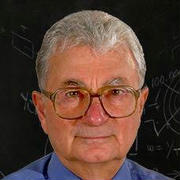Quick Facts

Biography
Yuri Tsolakovich Oganessian (Russian: Юрий Цолакович Оганесян [ˈjʉrʲɪj t͡sɐˈlakəvʲɪt͡ɕ ɐgənʲɪˈsʲan];born 14 April 1933)is a Russian-Armenian nuclear physicist who is considered the world's leading researcher in superheavy chemical elements. He led the discovery of these elements in the periodic table. He succeeded Georgy Flyorov as director of the Flerov Laboratory of Nuclear Reactions at the Joint Institute for Nuclear Research in 1989 and is now its scientific leader. The heaviest element on the periodic table, oganesson, is named after him, only the second time that an element was named after a living scientist (the other being seaborgium).
Personal life
Yuri Tsolakovich Oganessian was born in Rostov-on-Don, Russia, on 14 April 1933 to Armenian parents. His father was from Rostov, while his mother was from Armavir. Oganessian spent his childhood in Yerevan, the capital of then-Soviet Armenia, where his family relocated in 1939. His father, Tsolak, a thermal engineer, was invited to work on the synthetic rubber plant in Yerevan. When the Eastern Front of World War II broke out, his family decided to not return to Rostov since it was occupied by the Nazis. Yuri attended and finished school in Yerevan.
Oganessian was married to Irina Levonovna (1932–2010), a violinist and a music teacher in Dubna, with whom he had two daughters. His daughters reside in the U.S.
Career
—Flerov on Oganessian, 1990
Oganessian moved to Russia, where he graduated from the Moscow Engineering Physics Institute (MEPhI) in 1956. He thereafter sought to join the Institute of Atomic Energy in Moscow, but as there were no vacancies left in Gersh Budker's team, he was instead recruited by Georgi Flerov and began working at the Joint Institute for Nuclear Research (JINR) in Dubna, near Moscow.
He became director of the Flerov Laboratory of Nuclear Reactions at JINR in 1989, after Flerov retired, and remained in the position until 1996, when he was named the scientific leader of the Flerov.
Discovery of super-heavy chemical elements
In the 1970s, Oganessian invented the method of cold fusion, a technique to produce transactinide elements (superheavy elements). It played a vital role in the discoveries of elements from 106 to 113. From the mid-1970s to the mid-1990s, the partnership of JINR, led by Oganessian, and the GSI Helmholtz Centre for Heavy Ion Research in Germany, led to the discovery of six chemical elements (107 to 112): bohrium, meitnerium, hassium, darmstadtium, roentgenium, and copernicium.
His newer technique, called hot fusion, helped to discover the rest of the superheavy elements (elements 113–118). The technique involved bombarding calcium into targets containing heavier radioactive elements that are rich in neutrons at a cyclotron. The elements discovered using this method are nihonium (2003–2004; also discovered by RIKEN in Japan using cold fusion), flerovium (1999), moscovium (2003), livermorium (2000), tennessine (2009), and oganesson (2002).
Recognition

American chemist Sherry Yennello calls him the "grandfather of super-heavy elements." Oganessian is the author of three discoveries, a monograph, 11 inventions, and more than 300 scientific papers.
Honors and awards
In 1990 he was elected Corresponding Member of the Soviet Academy of Sciences and in 2003 a Full Member (Academician) of the Russian Academy of Sciences.
Oganessian holds honorary degrees from Goethe University Frankfurt (2002), University of Messina (2009), and Yerevan State University. In 2019, he was elected as an Honorary Fellow of St Catharine's College, Cambridge.
- State orders and awards
- USSR State Prize (1975)
- Lise Meitner Prize of the European Physical Society (2000)
- Order "For Merit to the Fatherland" 3rd class (2003)
- Russian Federation National Award (2010)
- Order of Honor of the Republic of Armenia (2016)
- Lomonosov Gold Medal (2018) "for fundamental research in the fields of interaction of complex nuclei and experimental evidence of existence of an 'island of stability' for superheavy elements"
- Demidov Prize (2019)
- Order of St. Mesrop Mashtots (Armenia, 2019)
Oganessian was granted Armenian citizenship in July 2018 by Prime Minister Nikol Pashinyan. Oganessian is a member of the Board of Trustees of the Foundation for Armenian Science and Technology (FAST). He is also the chairman of the international scientific board of the Alikhanian National Science Laboratory (Yerevan Physics Institute). In 2017 HayPost issued a postage stamp dedicated to Yuri Oganessian.
Oganesson
In early 2016 it was speculated by science writers and bloggers that one of the super-heavy elements would be named oganessium or oganesson. The International Union of Pure and Applied Chemistry (IUPAC) announced in November 2016 that element 118 would be named oganesson to honor Oganessian. It was first observed in 2002 at JINR, by a joint team of Russian and American scientists. Headed by Oganessian, the team included American scientists of the Lawrence Livermore National Laboratory, California. Prior to this announcement, a dozen elements had been named after people, but of those, only seaborgium was likewise named while its namesake (Glenn T. Seaborg) was alive. As Seaborg died in 1999, Oganessian is the only currently living namesake of an element.
Selected publications
- Oganessian, Yuri (13 September 2001). "Nuclear physics: Sizing up the heavyweights". Nature. 413 (6852): 122–125. Bibcode:2001Natur.413..122O. doi:10.1038/35093194. PMID 11557964.

